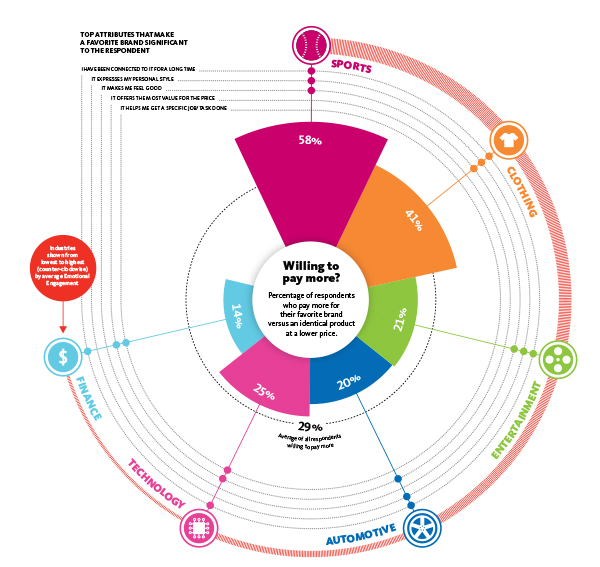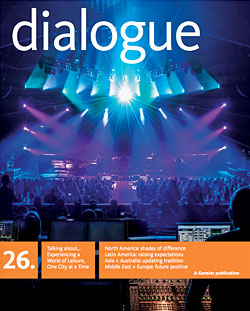Cheerleaders, Groupies & Fair-weather Fans
Emotional attachment is something brands desire from their customers, and with good reason, but Gensler’s 2013 Brand Engagement Survey found that there’s considerably more to the story.
Gensler’s 2013 Brand Engagement Survey lays it out. Customers with high levels of emotional engagement with their favorite brands will pay more for those products and services, and speak positively about them to friends and family. But products, services, and customers vary widely across brand categories—you feel differently about your favorite sports team than about your favorite bank.
Deanna Francl and Virginia Sertich, who spearheaded the survey, note that analyzing the data by category has interesting implications for brand engagement and evangelism. For example, when asked why their favorite brands are so significant to them, customers across the board noted long-term engagement as a key attribute—but then their responses diverge. Brands that elicit strong emotional connections speak to customers’ individual values—“makes me feel good” or “expresses my personal style.” Brands that elicit lower emotional engagement skew toward “value for the price” or “gets the job done.”

(Percent responding “very likely”)

Sports and Clothing brands are less likely to spread via word of mouth, despite high levels of emotional engagement. Financial brands are also challenged on recommendations.
(Percent responding “very satisfied”)

Clothing brands have a significant opportunity toimprove in-person customer experience.
(Percent responding “I would be devastated”)

Entertainment and Sports brands have the most die-hard fans, reporting high levels of devastation if the brand went away.
Passion doesn’t always translate to word of mouth
Customers across all brand segments reported a high likelihood of recommending their favorite brands to others—72 percent are “very likely” to do so. But for those with high levels of emotional connection, it rises to 84 percent. Split the data by brand category and a different story emerges: sports and clothing, the two highest emotional-engagement groups, fall to the bottom of the list, replaced by technology, entertainment, and automotive brands as those most likely to garner a recommendation. How did technology make it to the top? One explanation is that the more pragmatic nature of technology’s significance to consumers lends itself to sharing the news with others. They can easily envision enjoying something for its use-value alone, whereas it can be harder for them to empathize with a brand that’s aligned with its endorser’s feelings or personal style. That may be too subjective.
The equation isn’t cut-and-dried, of course—entertainment brands rank high for recommendations yet exhibit more personal significance, while automotive brands split the difference by focusing on both value and personal style. Are the style and expression we exhibit in our entertainment and vehicular choices more easily conveyed to others than our fashion and sports choices? And what about financial brands, whose customers rank low on both emotional attachment and likelihood of recommendation?
People, place, and product
Some things are universal. In-person interactions with brands appear highly aligned with likelihood of recommendation, so investing in the customer experience always makes sense. Of the factors that contribute to in-person experience, product availability is the most common attribute across the categories. This implies that failing to meet key needs will trump experience and connection. To reinforce the point, customers surveyed also said that of the different factors that contribute to brand loyalty, quality tops the list overall and in most categories.
The other responses stress the importance of people and place to success—staff friendliness and helpfulness also rank as highly important to in-person satisfaction. Sports brands are a notable exception. Design and location are big with sports customers: they’re not there for the staff, they’re there for the game and the fan experience.
Even when the focus isn’t on the staff, the importance of engaging and integrating customer values remains. The survey asked customers to indicate their own values and what they saw as their favorite brands’ key values. The alignment in responses is astonishing, both in aggregate and across the different brand segments. The variation in their chosen values harks back to the varying levels of emotional attachment across brand categories—and the importance of understanding how and why customers engage. Brand strategies should take this into account.
Tim Pittman, Gensler’s research communications manager, coedited its 2014 Research Catalogue.
Macaulay Campbell is an information design strategist with Gensler, based in New York.

